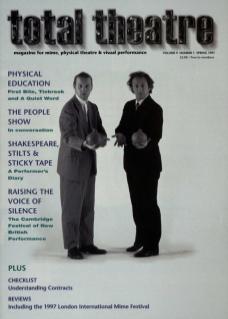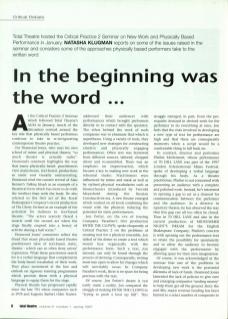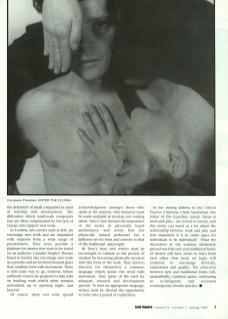At the Critical Practice 2 Seminar which followed Total Theatre's AGM in January, much of the discussion centred around the key role that physically based performers continue to take in re-invigorating contemporary theatre practice.
For Desmond Jones, who runs his own school of mime and physical theatre, ‘so much theatre is actually radio’. Desmond's comment highlights the way that many physically based practitioners view mainstream, text-based, productions as static and visually uninteresting. Desmond cited the current revival of Alan Bennet's Talking Heads as an example of a theatrical form which has more to do with the intellect than with the body. He also referred to the first act of the Royal Shakespeare Company's recent production of The Cherry Orchard as an example of the potential for dullness in text-based theatre. ‘The actors scarcely flexed a muscle until the second act when the stage finally erupted into a frenzy of activity during a ball scene.’
Desmond Jones' comments reflect the dread that many physically based theatre practitioners have of text-based, static, theatre – which can so often deny actors' expression. What these practioners search for is a verbal language that complements the body-based vocabulary of their work. They place movement at the fore and embark on rigorous training programmes which provide them with a physical language to equip them for the stage.
Physical theatre has progressed rapidly since the late 70s when companies such as DV8 and Eugenio Barba's Odin Teatret addressed their audiences with performances which brought performers directly into contact with the spectator. The ethos behind the work of such companies was to eliminate that which is superfluous. Using a variety of tools, they developed new strategies for constructing emotive and physically engaging performances. Often text was borrowed from different sources, tailored, chopped about and reassembled. There was an emphasis on improvisation, which became a key to making new work in the rehearsal studio. Practitioners were influenced by mime and mask as well as by stylised physical vocabularies such as the biomechanics introduced by Vsevold Meyerhold during the Russian Constructivist-era. A new theatre emerged which worked on all levels combining the visual with the physical, reducing the potential for static performances.
Jon Potter, on the eve of touring Company Paradiso's first production Enter the Clown, spoke eloquently at Critical Practice 2 on the problems of creating text for a physical ensemble. Jon talked of his desire to create a text which would fuse organically with the performance form. Such a text, Jon stressed, can only be found through the process of devising. Consequently, writing must stay open to allow for changes which will inevitably occur. In Company Paradiso's work, there is no space for being precious with the text.
Of course, Jon Potter's dream is not easily made a reality. Jon compared the struggle of making Enter the Clown to ‘trying to push a boat up hill’. This struggle emerged, in part, from the prerequisite demand in devised work for the performer to do everything at once. Jon feels that the risks involved in developing a new type of text for performance are high and that there are consequently moments when a script would be a comfortable thing to fall back on.
In contrast, director and performer Phelim McDermott, whose performance of 70 Hill Lane was part of the 1997 London International Mime Festival, spoke of developing a verbal language through his body. As a theatre practitioner, Phelim is not concerned with presenting an audience with a complete and polished work. Instead, he's interested in opening a gap to act as a channel for communication between the performer and the audience. As a director in repertory theatre, he has observed the way that this gap can all too often be closed. Thus in 70 Hill Lane and also in the current production of Midsummer Night’s Dream for the English Shakespeare Company, Phelim's concern is with opening out the performance text to retain the possibility for spontaneity and to allow the audience to become engaged with the performance by allowing space for their own imagination.
Of course, it was acknowledged at the seminar that one of the problems in developing new work is the perennial dilemma of lack of funds. Desmond Jones lamented the lack of policies to give new and emerging companies 'seeding’ money to help them get off the ground. Since the mid 80s, major revenue funding has been limited to a select number of companies to the detriment of small companies in need of training and development. The difficulties which small-scale companies face are often compounded by the lack of venues who support new work.
In London, arts centres such as BAC do encourage new work and are inundated with requests from a wide range of practitioners. They even provide a platform for unseen new work to be tested on an audience. Camden People's Theatre based in Euston also encourage new work as a priority and are inclined towards plays that combine texts with movement. There is still some way to go, however, before sufficient venues are prepared to take risks on booking work which often remains unfinished up to opening night, and beyond.
Of course, there was widespread acknowledgment amongst those who spoke at the seminar, that resources must be made available to develop new writing talent. Tony Craze stressed the importance of the writer in physically based performance and noted that the physically trained performer has a different eye for form and content to that of the traditional playwright.
In Tony's view, new writers must be encouraged to embark on the process of creation by becoming physically involved with the form of the work. They need to discover for themselves a common language which unites the word with movement. Tony spoke of the need for adequate research and development periods. To find an appropriate language, writers must be allowed the opportunity to enter into a period of exploration.
In her closing address to the Critical Practice 2 Seminar, Claire Armitstead, Arts Editor of The Guardian, noted: ‘ideas of work and play... are crucial to society, and this sector can teach us a lot about the relationship between work and play and how important it is to create space for individuals to be individuals’. What the discussion at the seminar ultimately proved was that new and traditional forms of theatre still have much to learn from each other. New work, we hope, will continue to encourage diversity, exploration and quality. The crossover between new and traditional forms will, undoubtedly, continue apace, continuing to reinvigorate and reinvent contemporary theatre practice.


